 First Christian Church
First Christian Church
- Built: 1942
- Address: 531 5th Street
- Design Architect: Eliel Saarinen
- Interior Design Collaboration: Eero Saarinen
- Interior Design Collaboration: Charles Eames
- Associate Architects: E.D. Pierre and George Wright
- Contractor: R. Wermuth & Sons (Fort Wayne, Indiana)
- Addition (2002) Architect: Nolan Bingham (Columbus, Indiana)
First Christian Church suddenly appeared in little Columbus, Indiana in the early 40’s. It has always amazed me at what a startling sight it must have been at the time. The church members were at least informed and hopefully enthusiastic about the bold new look of their church but townspeople must have been puzzled to see this still intriguing building being built. Newspaper reports at the time listed curious questions that the contractors were being asked: “is it a tomb?”, “a factory?”, “a defense plant?”. The First Christian Church (originally known as the Tabernacle Church of Christ) was completed in 1942. Considered to be an example of the Modernist or International style, it was the first Modernist building in Columbus and one of the first churches in the United States to be built in a contemporary architectural style. The building project was recognized nationally for it’s innovative design, especially in light of its small town setting. At the time it was regarded as the nation’s most unique church and had a substantial impact on post WW2 church design, one of the factors leading to its designation as a National Historic Landmark. Although it was rumored at the time to be one of the most expensive churches ever built, it was described by architect Eliel Saarinen as a “simply designed church for simple people”.
The church came about as a result of the growth of the Tabernacle Church in Columbus. Organized in 1855, they were outgrowing their old church built in 1878 which was a half block north on the west side of Lafayette Street towards the rear of the current library building. Prominent among the congregation was the Irwin-Sweeney-Miller family who lived in the house diagonally across the street from the present site. The original church was just across Lafayette street from the rear of their former home which still stands. William Glanton Irwin and his sister Linnie Irwin Sweeney (wife of former pastor Z.T. Sweeney) purchased the former “railroad square” property from the Pennsylvania Railroad. Although the rails had been relocated years earlier and the site had become a city park, the railroad retained ownership and the city had been unwilling to purchase the site. Besides the purchase of the land, the family was also willing to contribute a substantial donation to the building fund. Although the church building committee made the final decisions the design of the project was largely decided by the Irwin-Sweeney Miller family.
An initial architect was chosen but he was unable to complete the project. The building that he was designing was modern but still had a rather traditional look. With him out of the picture a search was on for another architect. J. Irwin Miller was fresh out of college and beginning to take his place in the family business enterprise. He had developed a love of modern architecture during his college years and encouraged his family to seek out an architect with a fresh perspective. Some of the family members have mentioned that Frank Lloyd Wright was briefly considered but rejected due to what the family felt were moral failings in his personal life. It is not believed that any direct discussion with Wright ever took place. The family was reluctant as well to embrace modern architecture but after consulting various respected sources they were persuaded to pursue modern architecture to make the statement that church wanted to express.
Eventually the family and the church board and building committee became interested in Eliel Saarinen, a native of Finland who had designed almost all of the original campus at the Cranbrook Academy in Bloomfield Hills, Michigan. Saarinen was the head administrator at Cranbrook as well as running his own architecture office. Initially Saarinen turned down the offer but was persuaded by J. Irwin Miller that the congregation was ready to move on to a new era in Christianity. Saarinen felt that churches in the United States were too “theatrical” and had turned down other requests in New York and Philadelphia. Eliel Saarinen was joined by his son Eero who was by then part of the firm and Charles Eames. Eero Saarinen and Charles Eames designed much of the interior furnishings. Eames later became famous for his numerous iconic furniture and chair designs. Eero Saarinen went on to become one of the greatest architects of the 20th Century and was a noted chair designer as well. Charles Eames designed the children’s furniture, much of which was regrettably sold at a church rummage sale unaware of their growing value. It was in Columbus as part of the planning process that J. Irwin Miller became close friends with both Eero Saarinen and Charles Eames. They would often meet at the downtown Zaharakos Ice Cream Parlor to discuss architecture, philosophy and their many plans for the future.
Saarinen described his building as a “geometric design of direct simplicity”, a composition of interlocking rectangular blocks of varying sizes and heights. The building is asymmetrical, described by Saarinen as an example of “broken symmetry”. The cross on the front and in the sanctuary is off-center as is the clock on the bell tower. This had to be disconcerting to traditionalists in the 40’s and even today used to seeing important items smack dab in the middle of a composition. Ornamentation on the exterior of the building is very sparse in keeping with the minimalist tradition. You will find simple geometric patterns used in various places around the exterior of the building. The exterior doors around the building have a pattern formed by wooden slats; although they look identical at first glance each one is slightly different in the way the slats are arranged. The slots in the exposed screwheads on the door are all turned vertical, an example of the attention to every detail that is a Saarinen tradition and indicative of the Finnish craftsmanship he grew up with. Many places throughout the building feature exposed hardware which was rarely done at the time, especially in a church. Modernism in architecture liked to feature the beauty of the hardware itself as an honest expression of materials. Throughout the building the woodwork shows great craftsmanship in the shaping and finishing.
Materials used were buff brick and limestone with steel framing. Luckily the steel was already purchased and construction underway as WW2 broke out or the church would have been much delayed as every bit of steel was going to the war effort. The brick has an interesting color mix that was also used in many of the buildings at Cranbrook. The original church campus consists of the East Wing (containing the tall rectangular sanctuary, chapel, the auditorium and kitchen) the 3-story West Wing containing classrooms and offices, the 166 ft detached Bell Tower (or Campanile) and the “Bridge Building” (a two story structure containing classrooms) which is elevated on huge concrete columns connecting the east and west wings. When viewed as a whole the geometric masses of the sanctuary, the bell tower, the west wing and the bridge building are in a perfect balance. In 1957 a separate Youth Center building was built across the street from the rear of the church. A very complementary addition was added to the rear of the church in 2002. It added much needed space with minimal impact on the original character of this National Historic Landmark design.
The front facade of the sanctuary building is a grid of limestone accented by a large stone cross. The “Jerusalem Cross” seen on the east outside wall was repeated by Saarinen on one single sanctuary pew (5 rows from the front and for no particular symbolic reason). It is also used on the exterior of the Youth Center.
Bell tower: the campanile (bell tower) is 17 by 23 feet at the base and stands 166 foot tall. Inside the tower there is a ladder leading to the top. It originally contained chimes controlled and played from a keyboard at the organ console inside and the bell from the original church. It also had a speaker system that could broadcast organ music from the tower. The original lattice-like openings in the brick were removed and replaced with molded plastic panels in 1976 to seal the tower due to structural problems caused by windblown rain and birds. The offset clock near the top is 10 feet in diameter.
Beside the sanctuary building and behind the bell tower is a sunken terrace intended to give all outside rooms natural light. A shallow 140 x 120 foot reflecting pool (between the north side of the bridge and the bell tower) was drained and filled in 1957 due to ongoing maintenance issues. It is now a grassy area and used often for outdoor gatherings.
Sanctuary: the sanctuary is 144 long, 46 feet wide (not including the wide side passageway) and 45 feet high. It can seat up to 1000 people including the upper gallery level in the rear. Many of the interior details such as light fixtures, railings, screen and furniture were designed by Eero Saarinen and Charles Eames. The center aisle is off-center as is the cross on the front wall. The only deviation from the “broken symmetry” is the communion table which is perfectly centered at the front of the church. Saarinen chose clear leaded glass to allow abundant natural light to enter the space. Each window has a slightly different geometric pattern in the leaded glass panes. The hanging lamps along the windows were meant to be reminiscent of the kind of oil lamps used in the early days of Christianity. The columns along the aisle were hand inlaid with mosaic tiles placed individually and perfectly spaced without a cut. The pews and most of the church furniture was constructed of bleached white oak. The aisles are tiled but there is cork flooring under the pews. Rather than using radiators on the side of the the space, the heating and air-conditioning system utilize very unique circular registers under the pews. The door handles leading to the sanctuary as well as a number of other doors around the building are covered in leather.
Tapestry: the large (35 x 11.5 feet ) tapestry on the side of the alter opposite the organ is entitled “Sermon on the Mount” and was designed by Eliel Saarinen and woven by his wife Loja and two Finnish weavers at the Cranbrook Academy. At the time it was the largest hand woven tapestry in the United States. It was removed in 1992 and returned to Cranbrook for a complete cleaning. It was discovered that some damage had occurred due to the opening and closing of the drapes that were installed to protect it from the sun. They now raise a covering over the huge side skylight during the week leaving the tapestry uncovered.
Organ: the organ is an Aeolian-Skinner custom designed for the sanctuary and behind the wood screen at the left side of the alter. Many organ enthusiasts come just to see and hopefully hear this splendid organ. It features 4595 pipes/81 ranks/7 manuals. Whether by accident or design, the acoustics of the sanctuary are superb. The sanctuary space is often used for community concerts as well.
The baptismal pool is at the very rear of the alter area behind a wood screen with ivy growing over the top. To the immediate left of the baptismal pool is a building high skylight meant to flood the rear wall containing the cross with natural light. Directly above the baptismal area is another skylight in the roof formed by glass block windows.
Chapel: the chapel lies directly behind the sanctuary area and is a miniature version of the main sanctuary space. The chapel features chestnut wood, a smaller baptismal pool and a much smaller Aeolian-Skinner pipe organ. The organ console is on rails so that it can slide back when not being used.The floor is still covered with the original cork flooring. The chapel columns are covered in leather matching the door handles to the sanctuary. In this case Saarinen used radiators for heating but they are encased in pierced brick along the side walls.
On the lower level is a large fellowship hall/auditorium area with kitchen facilities.
The church was dedicated on May 31st, 1942 and was debt free. Major benefactors William Glanton Irwin (who died in 1943) and his sister Linnie Irwin Sweeney (who died in 1944) lived just long enough to see their dream completed.
A large Youth Center building was built in 1958 with plans prepared by McGuire & Shook, Compton, Richey and Associates using a nearly identical brick color match. It contained a bowling alley, game room, skating rink and scout rooms on the lower level with a large gymnasium on the upper level. The project was made possible by a bequest from the late Hugh Th. Miller.
A complete restoration of the sanctuary , faithful to the original design was completed in 1992 to commemorate the 50th anniversary of the church.
First Christian Church was designated as a National Historic Landmark in 2001. It was cited for being one of the first modernist churches in the United States and as an outstanding example of the work of Eliel Saarinen. The landmark dedication ceremony marked one of the last public appearances by J. Irwin Miller who was by then in failing health and died in 2004. At the time I was fairly new to the community and was just realizing the significance of the church itself as well as the impact that J. Irwin Miller and his family had on Columbus. I count myself lucky that I chose to attend.
Addition: in 2002, an addition was carefully executed so as not to disturb the integrity of the church or affect it’s National Historic Landmark status. Designed by local architect and church member Nolan Bingham; he added a very complementary addition at the rear of the property. Unable to match the rich color mix of the original brick, he chose a lighter monochrome brick. Bingham was faced with a thankless situation by accepting the job of altering a building that had become an icon both locally and by architecture fans and critics around the world. By all accounts the addition has been well received.
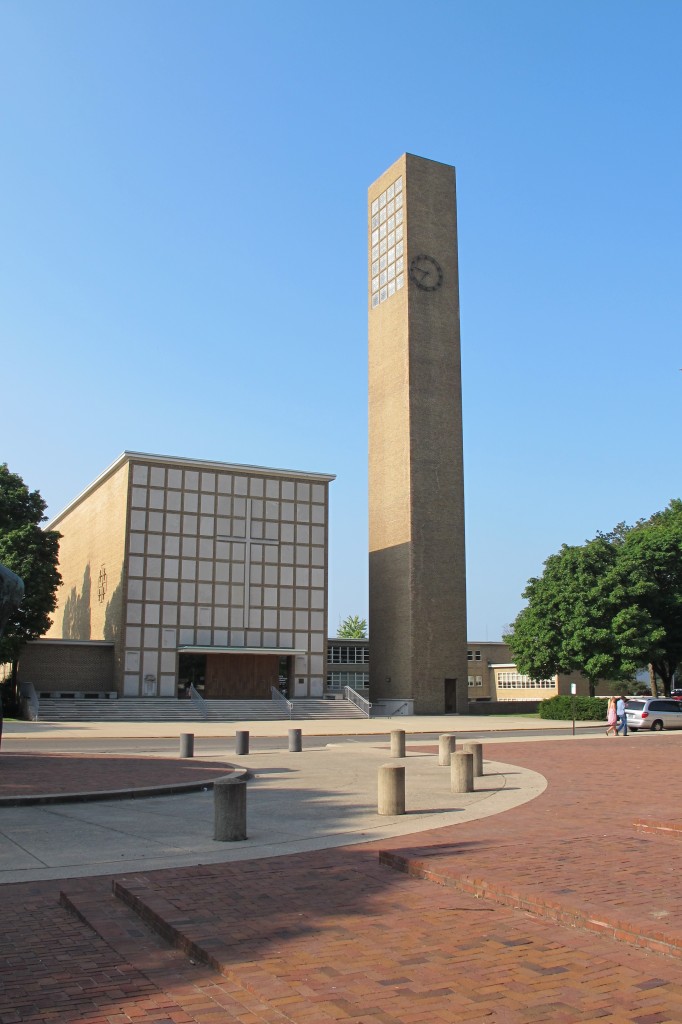 Santuary and Bell tower from the library plaza
Santuary and Bell tower from the library plaza
(photo by Ricky Berkey)
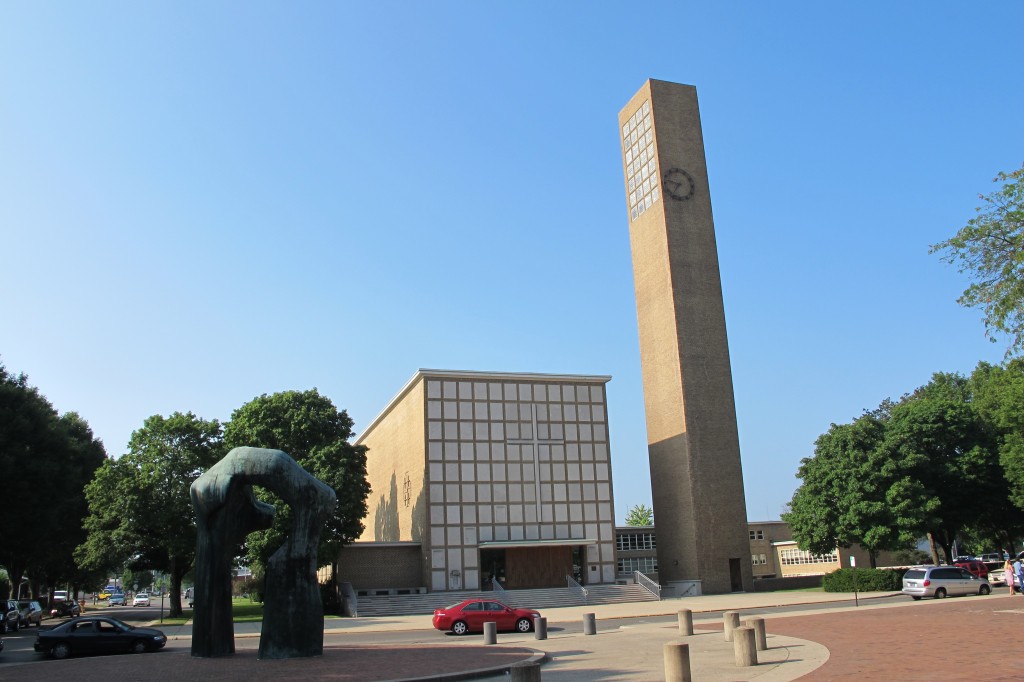 Exterior viewed from the library plaza
Exterior viewed from the library plaza
(photo by Ricky Berkey)
 Bell tower is a familiar site on the Columbus skyline, note the offset clock
Bell tower is a familiar site on the Columbus skyline, note the offset clock
(photo by Ricky Berkey)
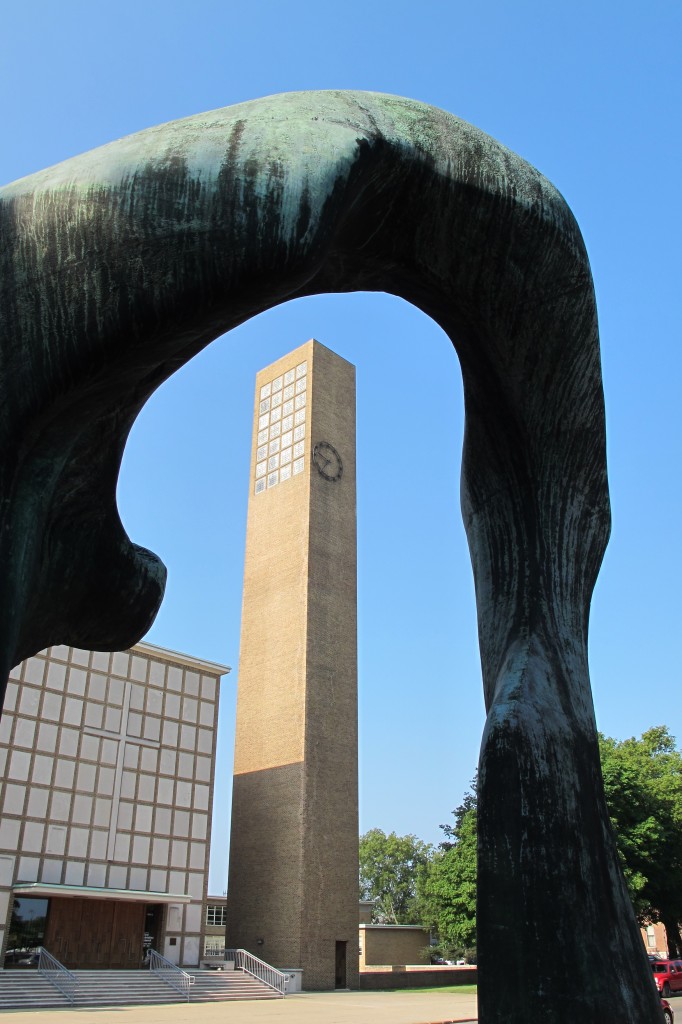 Bell tower is perfectly framed by the Henry Moore sculpture in the library plaza
Bell tower is perfectly framed by the Henry Moore sculpture in the library plaza
(photo by Ricky Berkey)
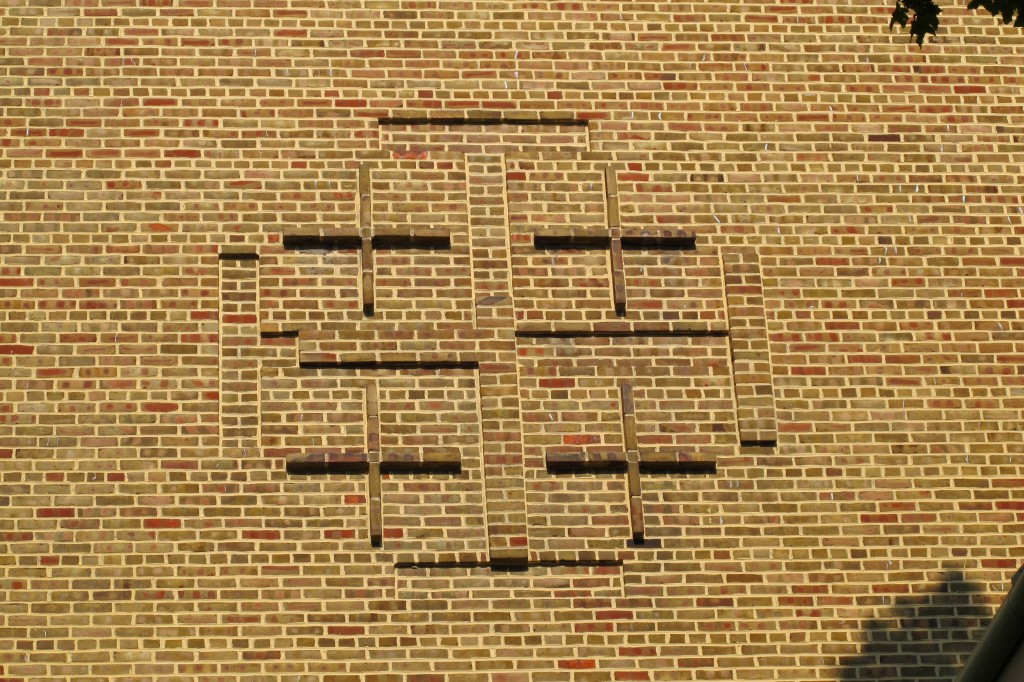 Jerusalem Cross motif on side of sanctuary
Jerusalem Cross motif on side of sanctuary
(photo by Ricky Berkey)
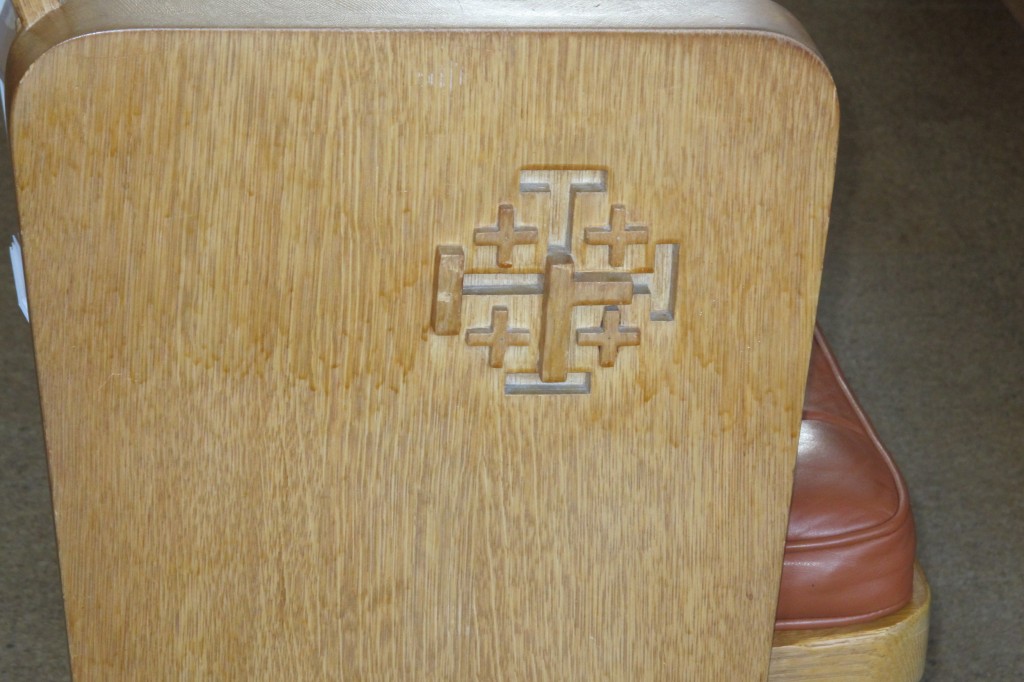 Jerusalem Cross motif repeated on one single pew, 5 rows from the front
Jerusalem Cross motif repeated on one single pew, 5 rows from the front
(photo by Ricky Berkey)
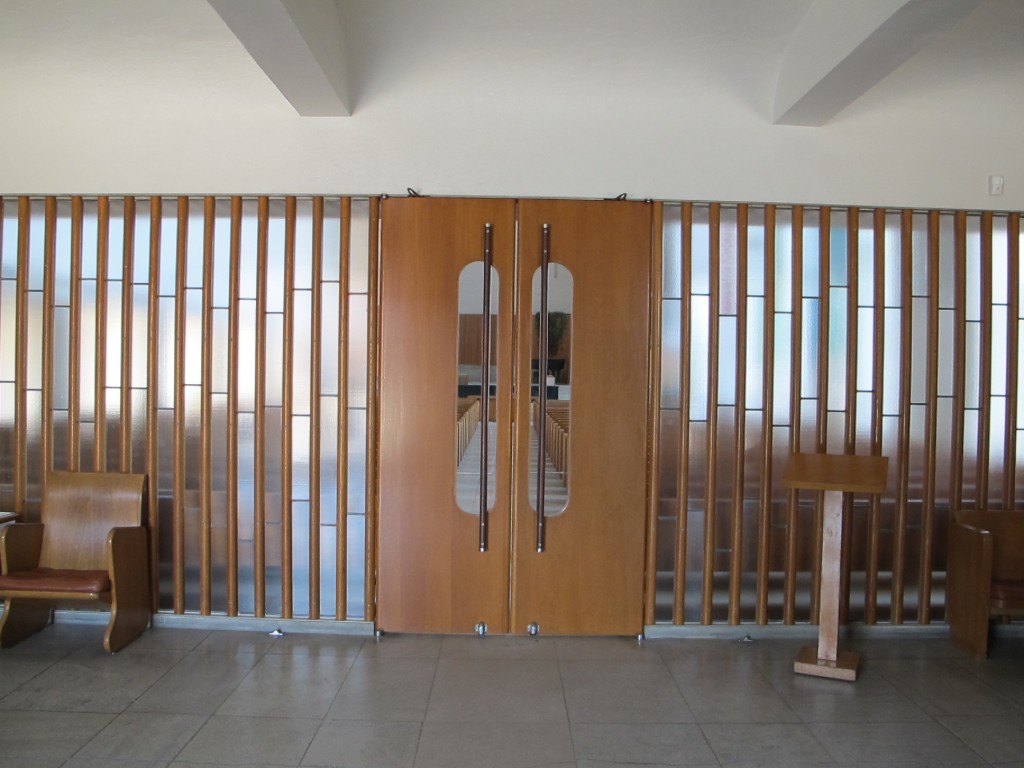 Front Lobby into sanctuary
Front Lobby into sanctuary
(photo by Ricky Berkey)
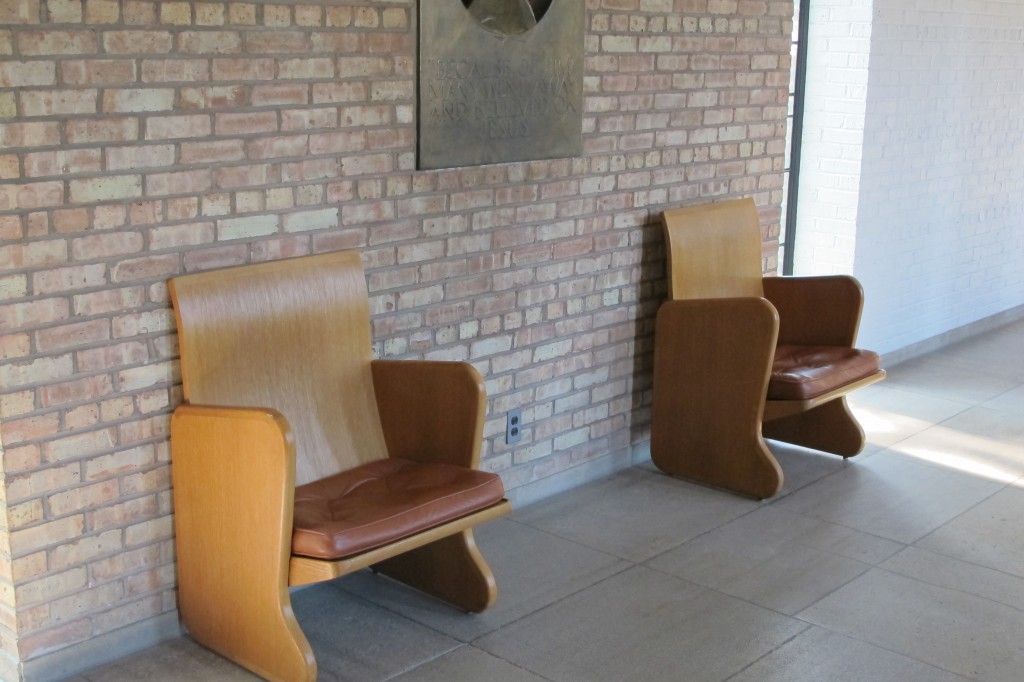 Lobby/aisle chairs
Lobby/aisle chairs
(photo by Ricky Berkey)
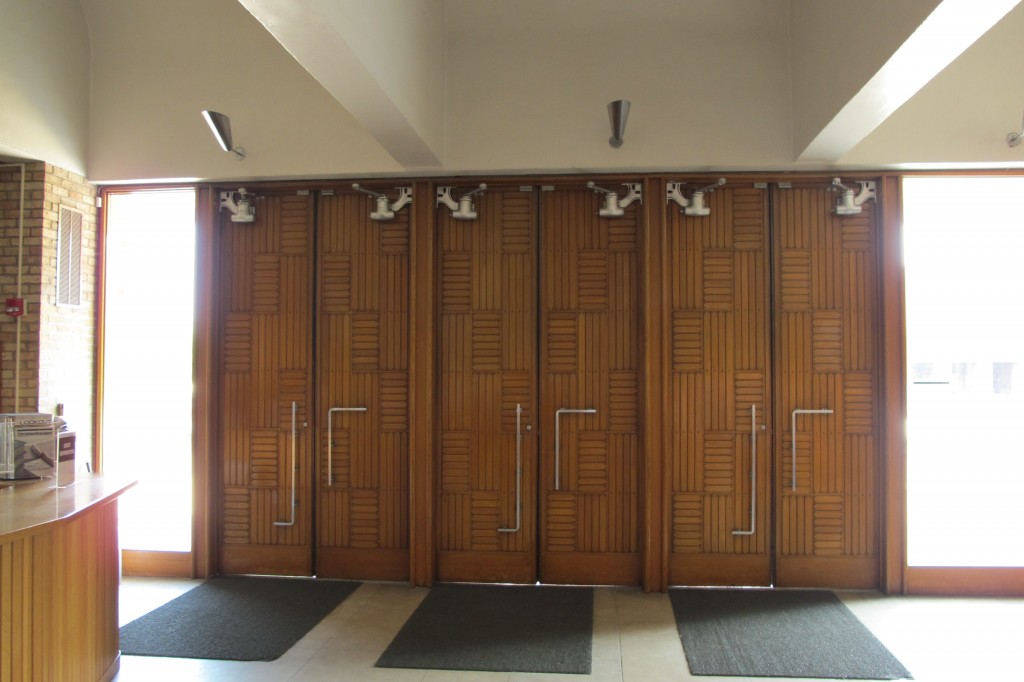 Lobby doors leading outside, note that each one is slightly different
Lobby doors leading outside, note that each one is slightly different
(photo by Ricky Berkey)
 Sanctuary seen from the balcony
Sanctuary seen from the balcony
(photo by Ricky Berkey)
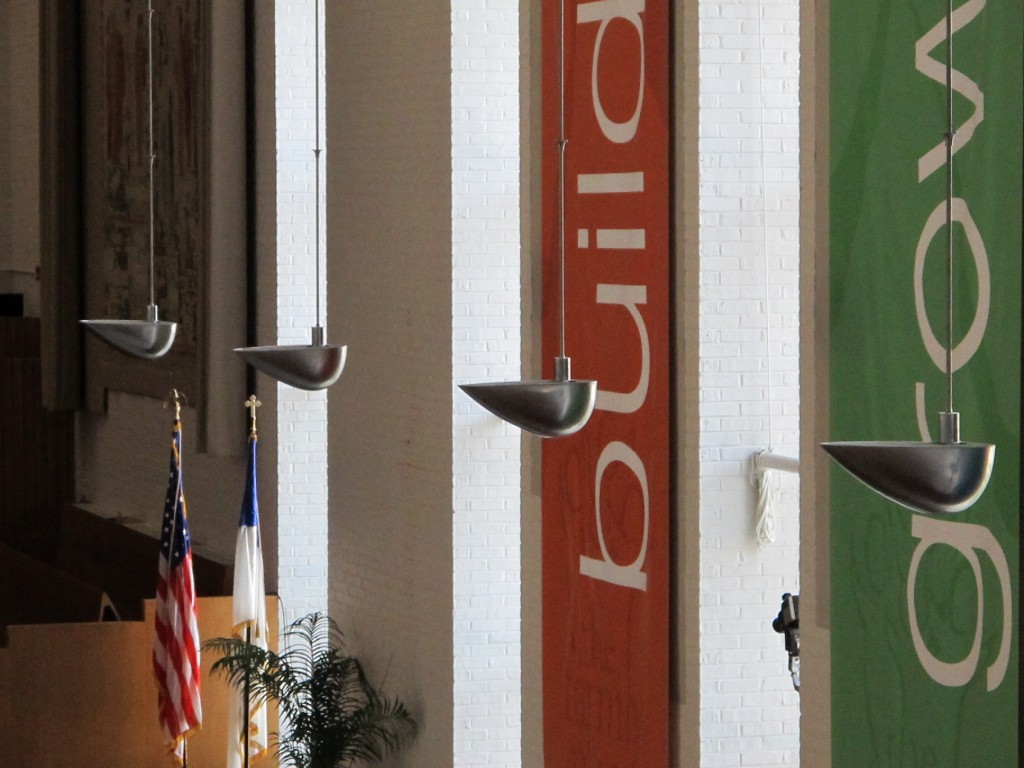 Hanging lamps in the sanctuary
Hanging lamps in the sanctuary
(photo by Ricky Berkey)
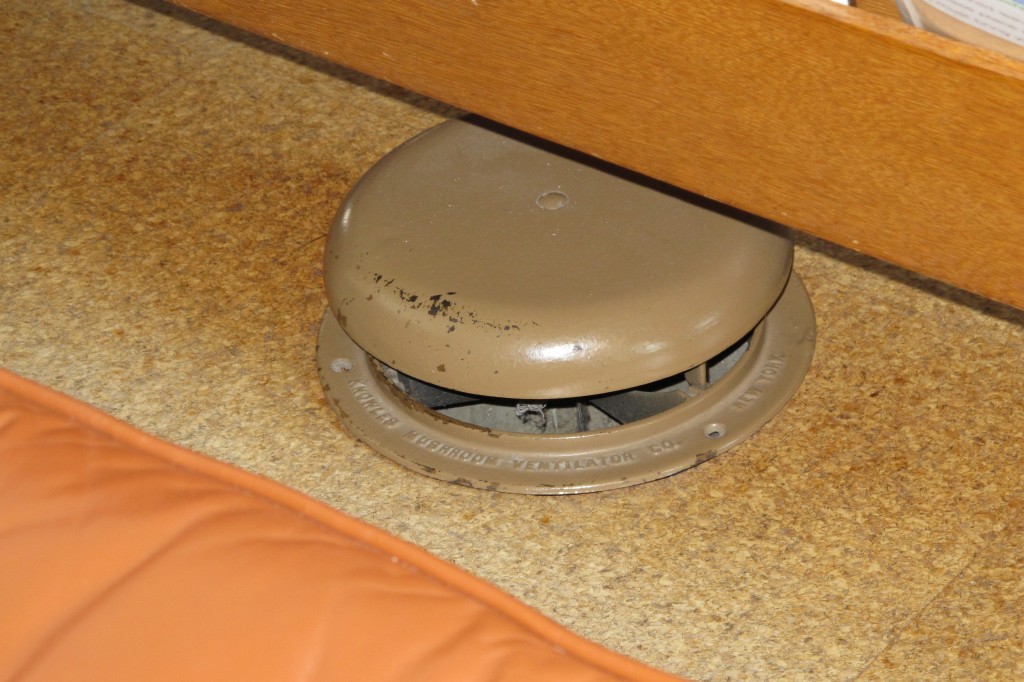 Under pew heating/cooling register
Under pew heating/cooling register
(photo by Ricky Berkey)
 Pulpit
Pulpit
(photo by Ricky Berkey)
 Looking to the rear of sanctuary from the altar
Looking to the rear of sanctuary from the altar
(photo by Ricky Berkey)
 Organ console
Organ console
(photo by Ricky Berkey)
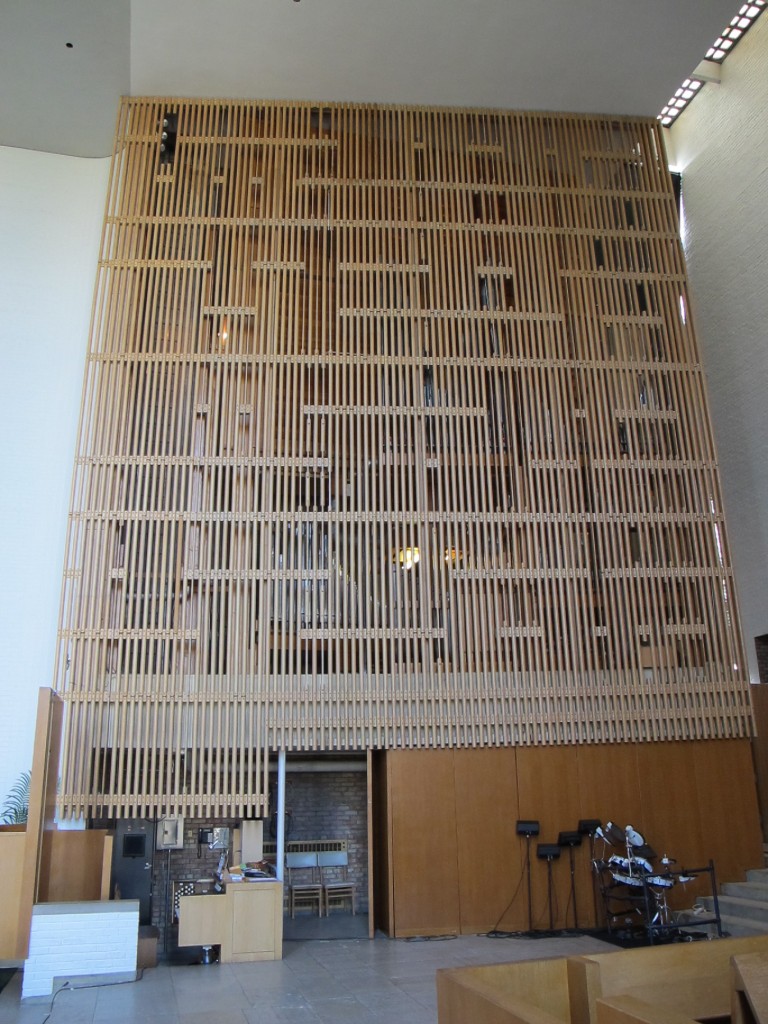 Organ pipes behind wooden screen
Organ pipes behind wooden screen
(photo by Ricky Berkey)
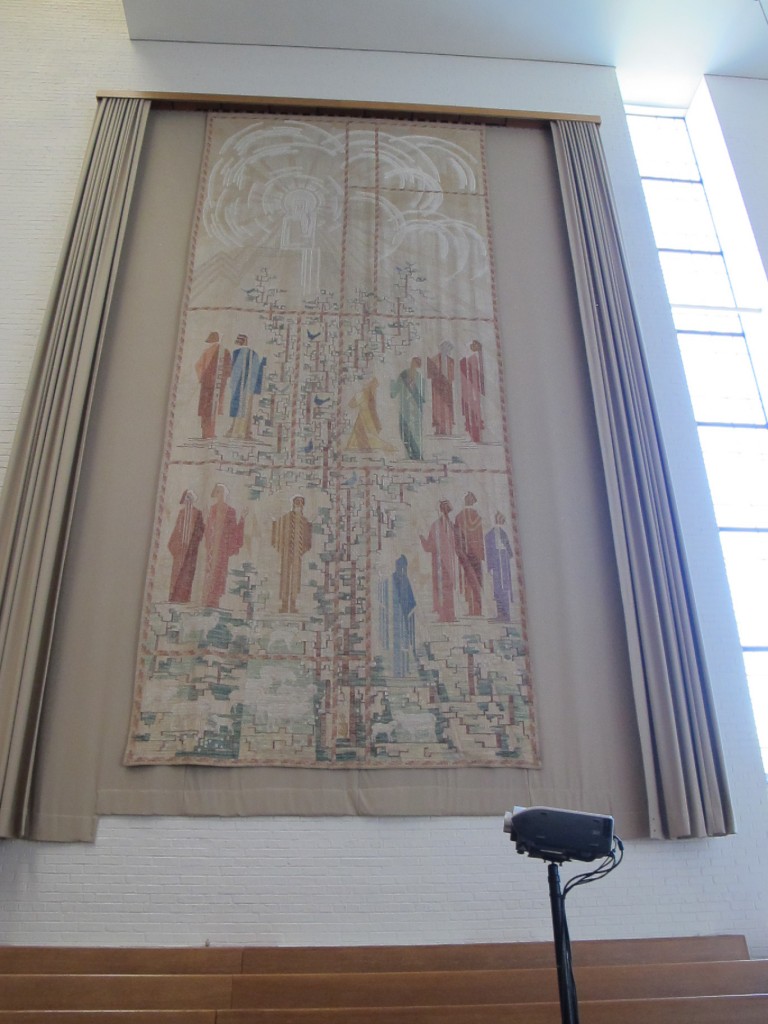 “Sermon on the Mount” tapestry
“Sermon on the Mount” tapestry
(photo by Ricky Berkey)
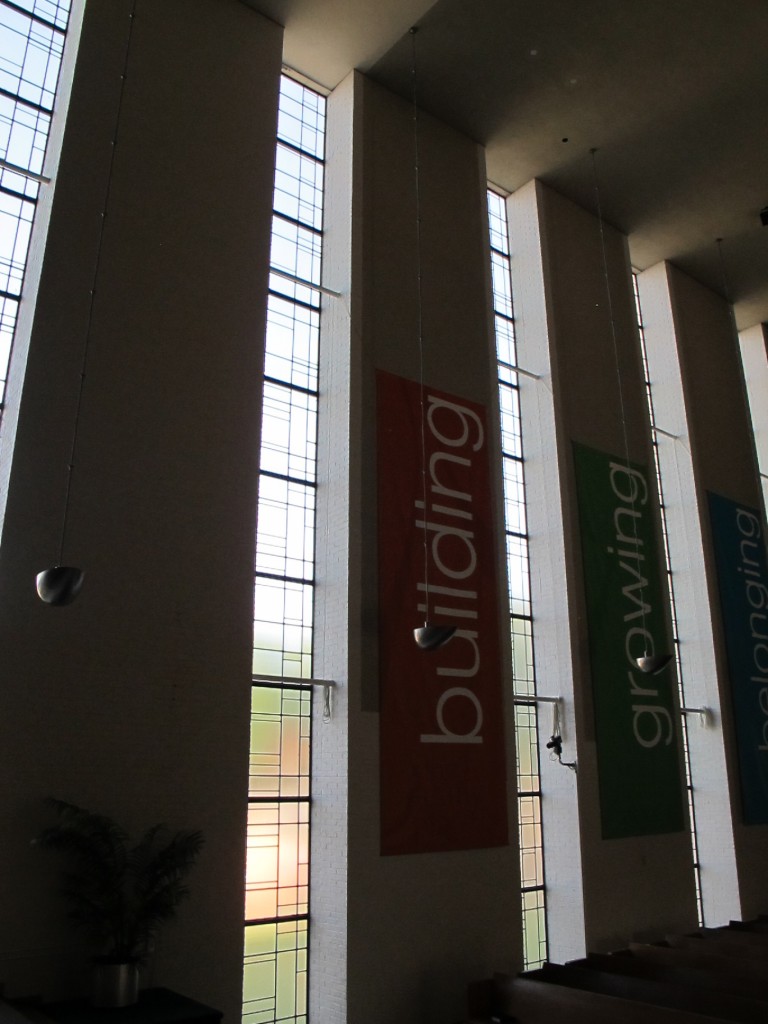 Leaded glass sanctuary windows
Leaded glass sanctuary windows
(photo by Ricky Berkey)
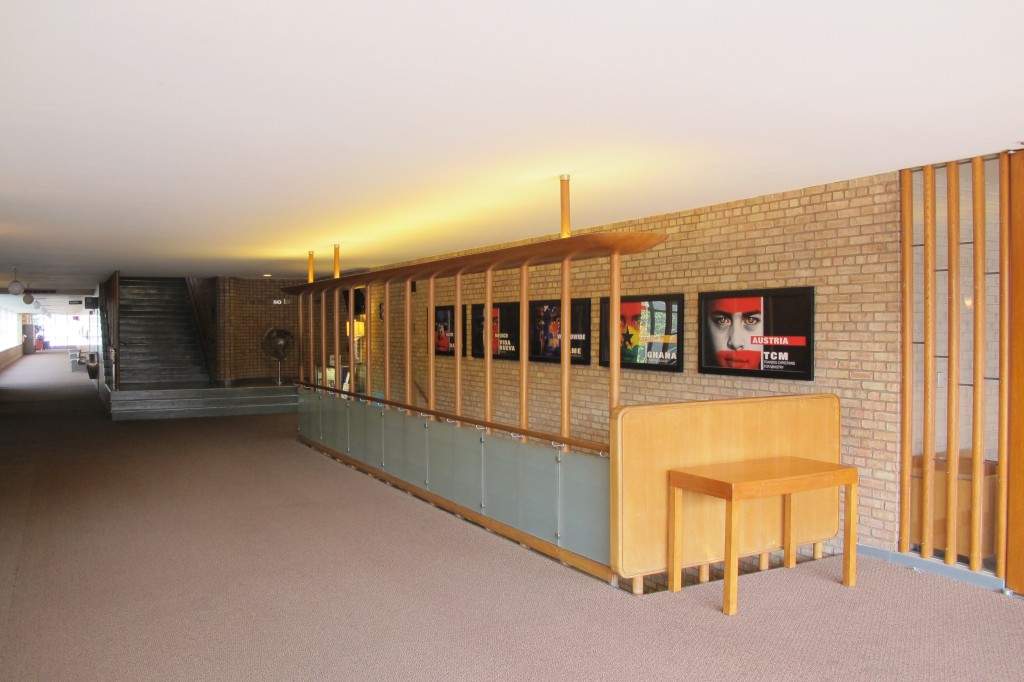 Lobby at the side entrance
Lobby at the side entrance
(photo by Ricky Berkey)
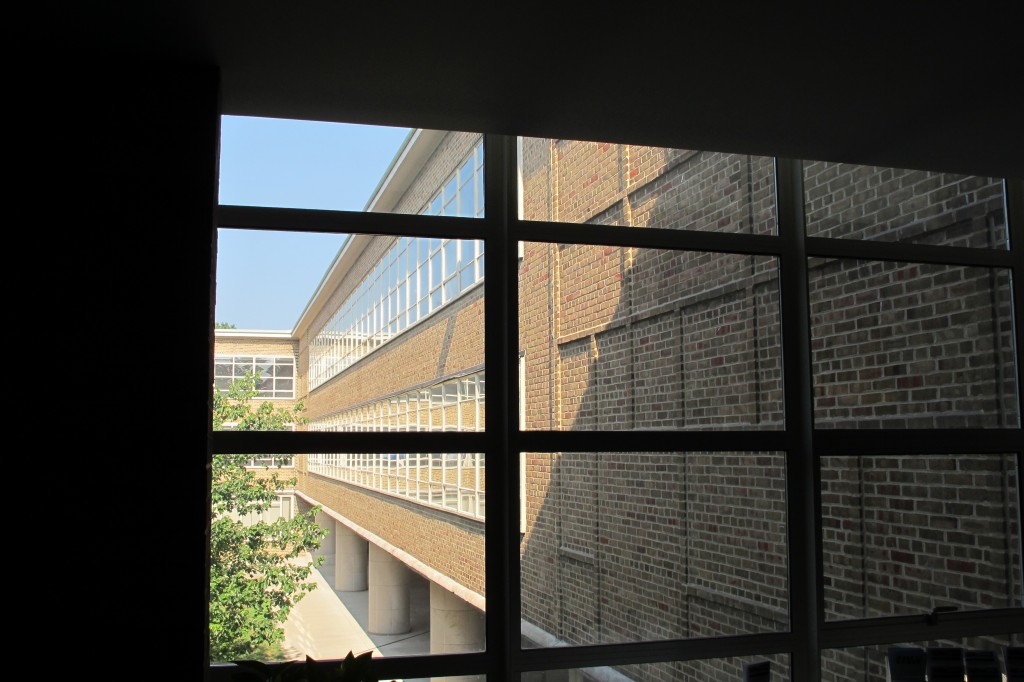 “Bridge Building” seen from an inside window
“Bridge Building” seen from an inside window
(photo by Ricky Berkey)
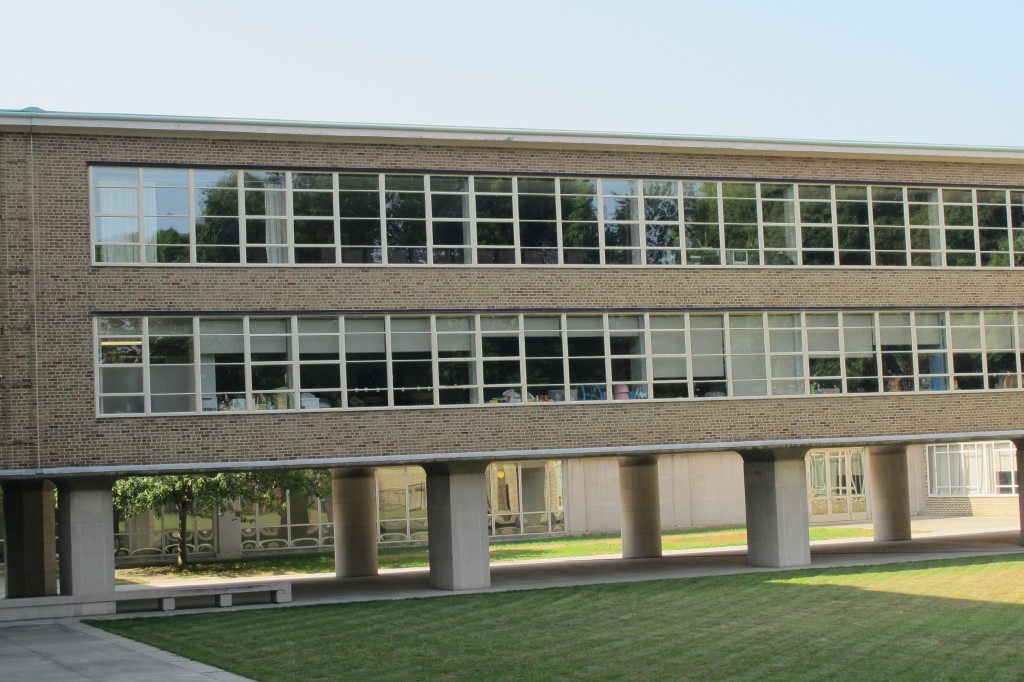 “Bridge Building”
“Bridge Building”
(photo by Ricky Berkey)
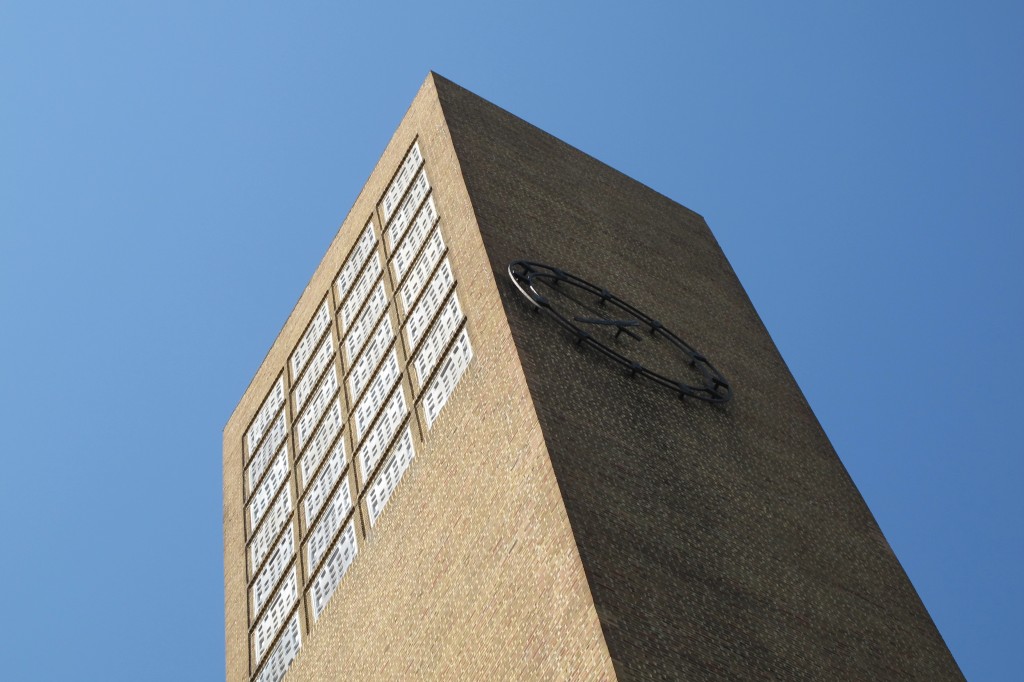 Bell tower
Bell tower
(photo by Ricky Berkey)
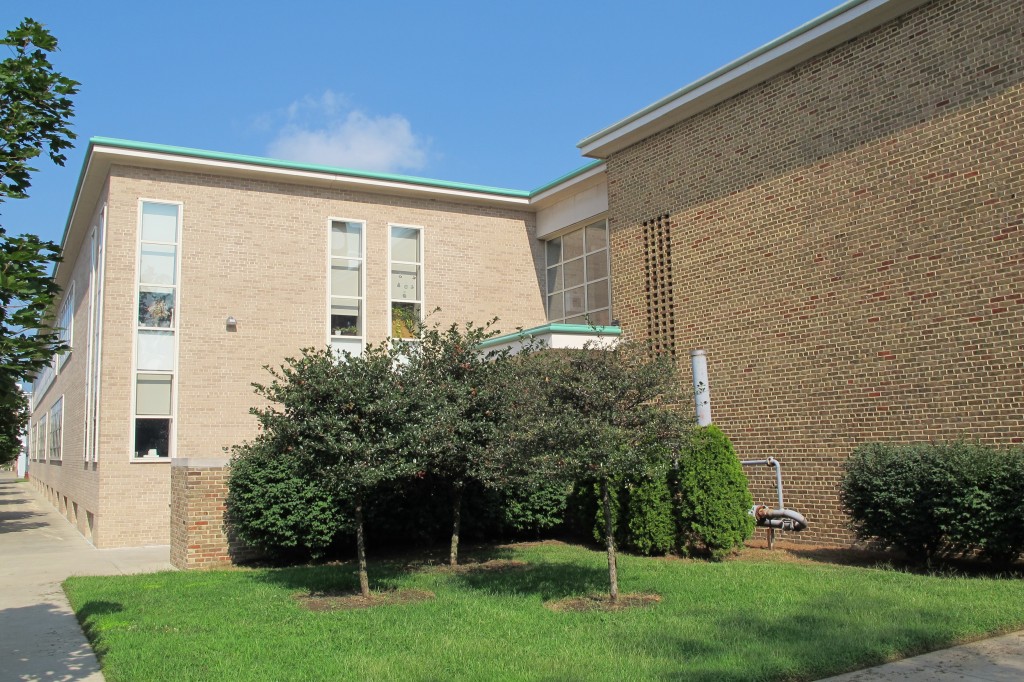 2002 addition, new building on the left, original on the right
2002 addition, new building on the left, original on the right
(photo by Ricky Berkey)
The Architects
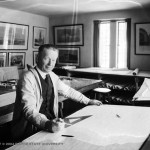 Eliel Saarinen
Eliel Saarinen
- Born on August 20th, 1873 in Rantisalmi, Finland
- University of Helsinki – Helsinki, Finland
- Helsinki University of Technology (1897)
- Died on July 1st, 1950
Gottlieb Eliel Saarinen was born in Rantisalmi, Finland in 1873. Educated in Helsinki, he originally envisioned a career in painting before becoming an architect. Saarinen helped pioneer the Arts and Crafts movement in Finland and was a leading proponent of the Art Deco and the modernist design movement. Saarinen first received international attention as the architect for the Finnish Pavilion for the Paris Exposition of 1900. This was the first building that Saarinen designed with the help of his classmates and partners, Herman Gesellius and Armas Lindgren. The three men worked together to design villas in northern Europe including Saarinen’s own villa, Hvittsask in 1903. Saarinen lived and worked there with wife Loja, daughter Pipsan (born in 1904) and son Eero (born in 1910). Saarinen, Gesellius and Lindgren designed the Finnish National Museum in 1912, considered the culmination of the National Romantic Movement in Finland and was their last building together. One of his most important works in Finland is the Helsinki Central Railroad Station utilizing local masonry techniques to emphasize bold architectural forms and expressive sculptural decoration. While still in Finland, he developed a deep interest in city planning which he continued to pursue throughout his career.
He came to the United States in 1923 after practicing as an architect for 25 years in Finland. He decided to emigrate to the US after winning 2nd place in a design competition for the Chicago Tribune Tower building in 1922. Although his design wasn’t chosen and was never built, it was highly regarded by many and gained Saarinen much attention in the architecture world. He used the prize money from the competition to move his family (including future architect Eero) to Chicago where he worked briefly before joining the faculty at the University of Michigan in Ann Arbor.
While at the University of Michigan he was recruited by Detroit newspaper publisher George Booth to be part of his efforts to develop the Cranbrook Academy in Bloomfield Hills, Michigan which Booth envisioned as an American equivalent of the Bauhaus in Germany. He went on to design most of the campus buildings and became the administrator of the campus as well as teaching architecture and city planning. Under his leadership Cranbrook became one of the most influential and respected design schools in the world. Many artists, designers and architects had connections to Cranbrook including Harry Weese, Charles Eames, Florence Knoll and many others.
He was in a partnership with his son Eero and J. Robert Swanson as Saarinen, Swanson and Saarinen from 1941-47 becoming Saarinen, Saarinen & Associates from 1947-1950. Eliel Saarinen died July 1, 1950.
Selected Eliel Saarinen Projects
1900: Finnish Pavilion at the Paris Exposition – Paris, France
1903: Hvitträsk (Eliel Saarinen’s home) – Kirkkonummi, Finland
1905: Clubhouse of Luther factory – Tallinn, Estonia
1911: Lahti Town Hall – Lahti, Finland
1912: National Museum of Finland – Helsinki, Finland
1913: Vyborg Railway station – Vyborg, Russia
1914: Helsinki Central Railway Station – Helsinki, Finland
1914: Joensuu Town Hall – Joensuu, Finland
1917: Saint Paul’s Church – Tartu, Estonia
1918: Marble Palace – Helsinki, Finland
1920: Munkkiniemi Pension House – Helsinki, Finland
1928-1942: Cranbrook Educational Community – Bloomfield Hills, Michigan
1938: Fenton Community Center – Fenton, Michigan
1939: Crow Island School – Winnetka, Illinois (a collaboration with son Eero)
1940: Kleinhans Music Hall – Buffalo, New, York (a collaboration with son Eero)
1942: First Christian Church – Columbus, Indiana
1944: Tanglewood Opera House – Lenox Massachusetts
1948: Des Moines Art Center (original wing) – Des Moines, Iowa
1949: Christ Church Lutheran – Minneapolis, Minnesota 1949 (striking resemblances to First Christian Church)
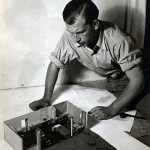 Eero Saarinen
Eero Saarinen
- Born in Kirkonummi, Finland on August 21st, 1910
- Died September 1st, 1961
- Cranbrook Academy
- Académie de la Grande Chaumière – Paris (1930)
- Yale University (1934)
- AIA Gold Medal Award
Eero Saarinen was a Finnish-American architect famous for taking modernism to different levels. He is most famous for his simple sweeping and arching sculptural shapes which were amazingly done before the era of computer-aided design and drafting had arrived. Unlike many of his contemporary architects, Eero Saarinen never had a particular defining style but insisted on a unique design to reach the architectural solution for each project.
He moved to the United States from Finland with his family in 1923 when he was 13. His father was Eliel Saarinen who had designed the campus at the Cranbrook Academy in Bloomfield Hills, Michigan as well as becoming the head of the Cranbrook’s Art, Design and Architecture School. Eero became a naturalized United States citizen in 1940. He studied sculpture and furniture design at Cranbrook and then went to Paris to study sculpture at the Académie de la Grande Chaumière in Paris, France. He completed his architectural study at Yale University in 1934 and began working with his father who had an architectural practice based out of his home at Cranbrook besides his academic work there.
He worked with his father from 1936-1950 with a wartime stint working for the Office of Strategic Studies (OSS) from 1942-1945. He gained national prominence on his own when he won the 1948 design competition for the Jefferson National Expansion Memorial (the iconic St Louis Gateway Arch).
After his fathers death, he began his own architectural firm in 1950 as Eero Saarinen & Associates. Besides his many buildings, he also designed interiors and furniture, especially well known for his Womb Chair and the Tulip Chair which were icons of the 50’s and still in production today. He had both studied at Cranbrook and taught there briefly where he had become close friends with Charles Eames who was also an architect as well as a furniture designer known for a number of very iconic chair designs. Eames later became a furniture designer associated with Herman Miller while Eero Saarinen designed furniture for Knoll (Florence Knoll was a graduate of Cranbrook). A number of both Charles Eames and Eero Saarinens furniture designs are still in production today.
Eero Saarinen died while undergoing surgery for a very unexpected brain tumor in 1961: he was only 51 and left behind at least 10 projects that were later completed by the Saarinen firm which was taken over by Kevin Roche and John Dinkeloo. Although his popularity as an architect fell out of favor for a few years there has been a recent surge of interest in his work and many critics have reassessed his work. Saarinen is now considered one of the masters of American 20th Century architecture. Eero Saarinen’s archival material has been donated to the Yale University Library by Kevin Roche.
Selected Eero Saarinen Projects
1940: Kleinhans Music Hall (with Eliel Saarinen) – Buffalo, New York
1940: Crow Island School (with Eliel Saarinen) – Winnetka, Illinois
1948: Womb Chair
1954: Irwin-Union Bank – Columbus, Indiana
1955: Kresge Auditorium (MIT) – Cambridge, Massachussets
1955: General Motors Technical Center – Warren, Michigan
1956: Tulip Chair (part of the “Pedestal” group which included arm and side chairs and tables)
1957: Miller House – Columbus, Indiana
1958 Concordia College (several buildings) – Fort Wayne, Indiana
1959: Yale Hockey Rink – New Haven, Connecticut
1962: Dulles International Airport – Washington D.C.
1962: Bell Labs – Holmdel, New Jersey
1962: TWA Terminal at JFK Airport – NYC
1964: North Christian Church – Columbus Indiana
1965: Gateway Arch – St Louis, Missouri
1965: CBS Building (“Black Rock”) – NYC
Links/References
First Christian Church website:
National Historic Landmark application form for First Christian Church:
Website focusing on the Aeolian-Skinner Pipe Organ:
3D Model of First Christian Church Executed in Google SketchUp:
City of Columbus: official City of Columbus website
Columbus Indiana Architectural Archives
Columbus Indiana Architecture Digital Archives: A small portion of the Columbus Indiana Architectural Archives available online from the IUPUI digital library
3D Models of Columbus Architecture Executed in Google SketchUp:
The Republic Newspaper – Columbus, Indiana newspaper
Bartholomew County Public Library
Historic Columbus Website – David Sechrest’s tribute to Columbus History
Historic Columbus Message Board – a companion interactive forum to the David Sechrest historical website
Bartholomew County Historical Society
 Click HERE for a Calendar of Upcoming Events in the Columbus Area.
Click HERE for a Calendar of Upcoming Events in the Columbus Area.
Click HERE for information about Tours of Columbus Architecture and Design including the Miller House.
 Ricky Berkey
Ricky Berkey
Email me: rickyberkey@gmail.com

Pingback: The C is for… | Indiana's Indiana
Thank you so much for publishing this detailed history of FCC. I attended there for approximately 20 years (from the time I was 2 until I graduated high school…and then again a few years later). My father was heavily involved with the church teaching several Sunday school classes, being a Deacon, Elder, and fulfilling the role of Chairman of the Board of Elders over a period of 30+ years. My mother worked as assistant to the pastor in the church office for over 15 years (through the late 80’s and 90’s). My brother and his family still attend.
There has been no other more important influence on who I am today than First Christian Church and the wonderful people there that impacted my life over so many years!
Pingback: First Christian Church | ID 161